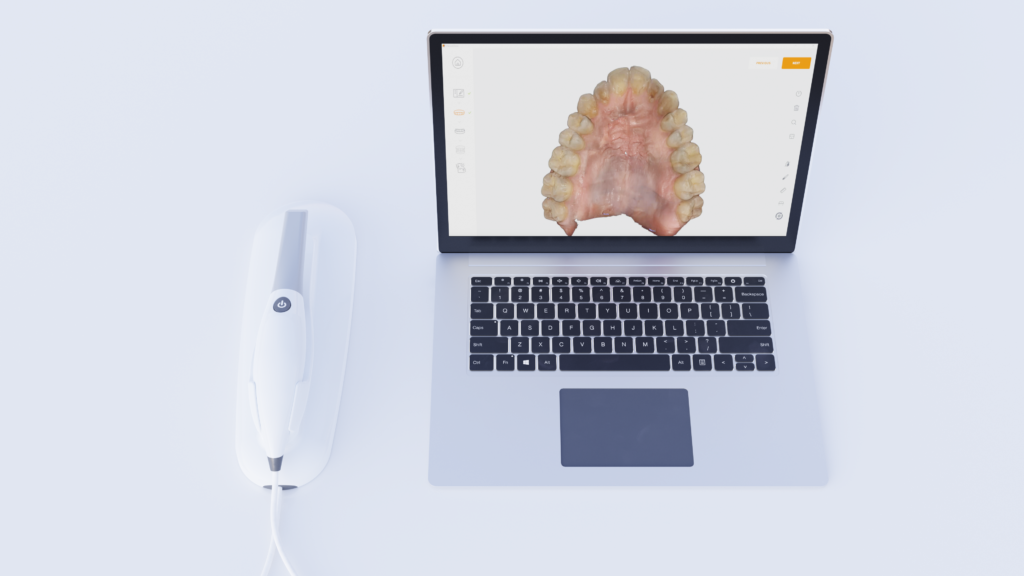Incorporating an intraoral scanner (IOS) into your practice is a transformative step toward modernizing workflows, enhancing patient care, and boosting efficiency.
However, selecting the right scanner can be overwhelming due to the vast array of options, features, and costs. This guide provides a detailed, impartial approach to help you make an informed decision tailored to your clinical needs.

Step-by-Step Guide to Choosing an Intraoral Scanner
Step 1: Define Your Clinical Needs
- Procedure Types: Identify whether your practice focuses on restorative dentistry, orthodontics, implantology, or a combination of these. Scanners with high-resolution imaging are critical for aligners and implants, while speed and ease of use may be priorities for pediatric practices.
- Patient Volume: High-volume clinics should prioritize scanners with faster scanning speeds to minimize chair time and optimize patient turnover.
- Space Constraints: Evaluate whether your clinic requires a compact or portable scanner, particularly if space is limited.
Step 2: Establish Your Budget
- Initial Costs: Entry-level scanners may start at ₹6,00,000, while premium options with advanced features can exceed ₹15,00,000.
- Operational Costs: Budget for recurring expenses like software subscriptions, updates, and consumables.
- ROI Calculations: Use a simple formula:

For example, reducing patient chair time by 10 minutes per scan could save an average of ₹2,000–₹3,000 daily in high-volume clinics.
Step 3: Evaluate Key Features
Resolution and Accuracy
- High resolution is essential for precision work like aligners, crowns, and implants.
- Look for a minimum of 10–15 μm accuracy for implantology and 20–25 μm for restorative dentistry.
Speed
- Scanning speeds vary by model, with advanced scanners processing a full arch in as little as 30–60 seconds. Faster speeds reduce patient discomfort and improve workflow efficiency.
Ease of Use
- Ergonomic designs and intuitive software reduce operator fatigue. Look for systems with minimal calibration requirements and user-friendly interfaces.
Step 4: Assess Workflow Integration
- CAD/CAM Compatibility: Ensure the scanner integrates seamlessly with your existing software. Compatibility with open file formats like STL and PLY is crucial for collaboration with labs.
- Cloud Integration: Check if the scanner offers secure cloud storage for digital impressions, enabling remote access and faster lab coordination.
Comparison Table: Key Features of Popular Scanners
| Feature | Compact Scanners | High-Resolution Scanners | Affordable Scanners | Scanners for Orthodontics | Scanners for Pediatric Dentistry |
| Price Range | ₹6,00,000 – ₹8,00,000 | ₹14,00,000+ | ₹6,00,000 – ₹10,00,000 | ₹10,00,000+ | ₹6,50,000 – ₹8,50,000 |
| Example s | Medit i600, Heron, Virtuo Vivo | 3Shape TRIOS 4,ovo | OVO, Heron, | iTero Element 5D, TRIOS 5 | OVO, Virtuo Vivo |
| PlanmecaEmerald | Condor Scan | ||||
| Resolution | Moderate | Very High | High | High | Moderate |
| Speed | Fast | Moderate | Moderate | Very Fast | Fast |
| Portability | Compact, portable | Fixed | Portable | Fixed | Compact, portable |
| Integration | Open file formats | Advanced CAD/CAM systems | Open file formats | Specialized orthodontic tools | Basic CAD/CAM compatibility |
| Best for | General dentistry, prosthetics | Advanced restorative cases | Clinics on a budget | Complex orthodontic workflows | Pediatric-foc used clinics |
Deeper Exploration of Challenges
1. Integration Issues with Existing Systems
- Problem: Older practice management systems or CAD/CAM setups may struggle to integrate with newer scanners.
- Solution: Confirm compatibility with your existing systems before purchase. Opt for scanners that support open file formats (STL, OBJ) to reduce friction.
2. Learning Curve for Staff
- Problem: Staff resistance or unfamiliarity with new technology can slow down adoption.
- Solution: Look for scanners with intuitive interfaces and ensure the vendor provides comprehensive training. Gradual implementation and regular team workshops can also ease the transition.
3. High Initial Investment
- Problem: Premium scanners may feel financially daunting for small practices.
- Solution: Evaluate ROI by comparing potential savings in materials and time. Some vendors offer lease-to-own plans, spreading costs over time.
4. Delayed Lab Turnaround Times
- Problem: Labs may require time to adapt to files generated by a new scanner, causing delays.
- Solution: Coordinate with your lab before purchasing and test a few cases to ensure smooth communication.
5. Maintenance and Downtime
- Problem: Scanners may require frequent calibration or occasional repairs, affecting workflow.
- Solution: Choose scanners with robust customer support and extended warranties. Keep a backup plan, such as access to traditional impression materials, for emergencies.
Case Studies
Case 1: Overcoming Staff Resistance
A general dentistry clinic introduced a scanner with user-friendly software and ergonomic design. Staff workshops led to a 90% adoption rate within two weeks, improving patient satisfaction scores by 30%.
Case 2: Managing ROI for Small Practices
A budget-conscious clinic adopted a scanner priced at ₹8,00,000. By reducing material waste and cutting impression-making time by 50%, the practice recovered its initial investment in 18 months.
Conclusion
Choosing the right intraoral scanner requires balancing your practice’s clinical needs, budget, and future goals. Addressing potential challenges, such as integration issues and staff training, can ensure a smoother transition to digital workflows.
This guide offers a starting point for informed decision-making. By leveraging varied examples and practical insights, it equips dentists with the tools needed to enhance efficiency, improve patient care, and achieve long-term success.

Leave a Reply